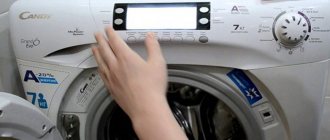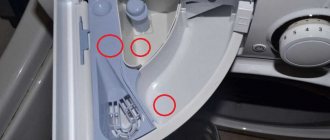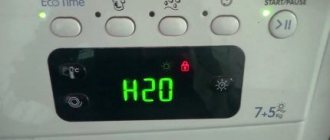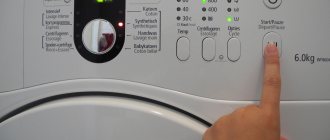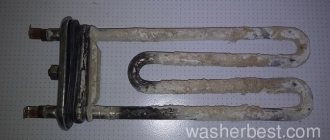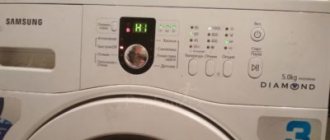With a slight movement of your hand, you loaded the dirty laundry into the drum, poured in the powder as usual, filled in the conditioner and calmly went about other things. But something went wrong during the washing process, because after it was completed, the powder remained in place, and dirty spots remained on the laundry.
Don't worry! The situation when the washing machine does not wash away the powder is quite common and, moreover, is often not associated with serious malfunctions. Therefore, remain calm and read our article to figure out what happened to your “assistant”.
How does the process of collecting powder and conditioner work?
To understand this, you need to find out the principle of this process for washing devices. All washing machines, as a rule, are equipped with special trays where detergent in the form of powder or gel, conditioner, fragrances, etc. are placed. Automatic washing machines have pull-out trays, inside of which there are 3-4 compartments designed for different stages of washing. During the washing process, water is supplied inside the tray, washing away powders, gels, and conditioners directly into the washing tank with laundry. Why doesn't the washing machine always pick up the powder from the compartment?
Does the container need to be cleaned?
Careful operation and proper maintenance are important for any equipment. Automatic cars are no exception. Only if you follow the manufacturer's recommendations and regular cleaning will the device last a long time.
The powder tray is not the most important part of the device. There is no need to clean the dispenser. Many users think so. They are confident that the strong water pressure when starting the program effectively washes out the detergents. This is wrong. Almost always, residues settle on the walls of the container. There are two reasons for this:
- Low-quality powder (the worse the detergent, the more of it will remain on the walls).
- Weak water pressure in the riser greatly increases the likelihood of poor rinsing of the product from the container.
Ditch bleaches and conditioners are truly evil. Such chemistry settles on the sides of the tray in the form of a sticky and slippery film, which hardens over time.
This causes blockages. They can lead to equipment breakdown and failure.
If a serious breakdown occurs and the repairman says that the reason for this is contamination of the detergent container, it will be very insulting and annoying.
It is important to figure out how to properly clean the powder compartment and how to wash the cuvette?
Blame the powder
The composition of the washing powder is also important. Very often, the desire to save money leads to the purchase of counterfeits, which have the most distant relation to SMS. The insoluble compounds they contain remain in the tray, causing accelerated overgrowing of the compartment and pipes. Save wisely and buy detergent from well-tested brands at official retail outlets.
Advertising gimmicks often mislead us into buying more expensive and supposedly more effective washing powders with blue and red granules. In fact, such inclusions do not affect the quality of the product and the washing result, but only increase the weight of the purchased product.
The amount of powder poured into the tray must correspond to the washing mode. A measuring spoon or measuring cup will also come in handy here.
Clean the powder flush channel in the dispenser
If the washing machine does not completely remove the powder from the tray, the reason may be a clogged powder flush channel due to a blockage formed there. This can happen due to the use of cheap, low-quality powder that does not dissolve properly. In addition, hard water may be to blame, as well as foreign objects getting into the tray. One day, our client dropped tweezers into the tray, but noticed it was missing in time and thought to call a professional.
Check the channel through which the powder is fed into the drum and, if necessary, clean it yourself using a soft toothbrush or flexible brush.
Boris Vitalievich
Who will help to repair?
Professionals working in . can help with the repair of household appliances from any manufacturer. Employees regularly improve their skills and have the necessary permits and certificates. A warranty card is issued for installed spare parts and work performed.
The technicians quickly travel to all areas of Moscow, New Moscow, and the Moscow region, carrying with them the necessary diagnostic and repair equipment. An urgent call is possible, which is completed within 2 hours.
You can call a specialist by phone every day, seven days a week, from 8.00 to 21.00. You can fill out an application on the service center website (24/7) or use messengers (Whatsapp, Viber, Telegram).
In what cases is it necessary to contact a specialist?
Everything regarding external causes of malfunctions associated with the remaining powder in the tray, such as problems with the powder, mesh filter, clogged pipes, can be eliminated independently. But everything that relates to malfunctions of the water supply system, software module or replacement of inlet valves is best entrusted to specialists who carry out repairs, following the manufacturer’s flow charts, using original spare parts.
Watch a video about why the washing machine does not wash away powder well
Reasons why washing powder hardens during washing:
There is an automatic washing machine in almost every home. It greatly simplifies the life of the housewife, because all you need to do is put the laundry in the compartment, pour the powder into a special tray, and turn on the button. But not all housewives are happy with the appearance of their washed clothes or the performance of their washing machine.
Often, a device that has served faithfully for several years begins to act up and produce poorly washed laundry with stains or pieces of powder stuck to the fabric. This occurs because the powder in the tray hardens and is not completely washed out. As a result, the laundry is only partially washed. The hardened powder does not dissolve in water and sticks to fabric, buttons on clothes, snakes, etc.
The reason for hardening of the washing powder may be:
- Weak water pressure.
- Poor quality detergent.
- Washing machine malfunction.
Weak water pressure
Low water pressure does not allow the powder to be completely washed out of the tray. This will help fix this:
- Checking the water supply valve to the hose connected to the pipe. It is necessary to check whether the valve is fully open.
- Checking the water supply system in the device.
- Checking the dispenser in the tray. It is recommended to rinse the tray thoroughly after each wash, as the dispenser can also become clogged with dirt and small particles.
- Checking water pressure in water pipes. To do this, you can simply open the tap in the bathroom or kitchen and see how well the water flows. If the pressure is weak, it is recommended to contact plumbers or the management company that services the house.
Poor quality washing powder
Incorrect use of detergent or its poor quality often causes the powder to harden in the tray. To avoid this, it is recommended:
- Check the information on the powder packaging. It should indicate that the product is suitable for automatic washing. Hand wash detergent is not suitable for washing machines. Experts do not recommend pouring powder containing chlorine into the tray, since chlorine has a detrimental effect on the rubber parts of the machine.
- Check the quality of the powder. Perhaps it's a fake. To check the quality of the powder at home, you need to stir a little product in a glass, add 3 - 4 drops of ordinary brilliant green to the solution and wait. After a few minutes, the greenish solution should turn pale. If the color of the solution has not changed, this indicates poor quality of the product.
- Use a measuring spoon or glass when pouring the product into a special recess in the tray. Experts advise using as much detergent for washing as indicated on the packaging by the manufacturer. If the previous recommendation did not help, then you can try reducing the amount of powder added to the tray. The following consumption is considered the norm: 1 tablespoon of product per 1 kg of dry laundry.
- Check whether the machine is overloaded. Do not put laundry in the drum too tightly.
Washing machine malfunctions
The reason why detergent remains in the tray and is not washed out, hardening and sticking to clothes, may be a malfunction of the washing machine itself. You can deal with some breakdowns yourself, without the help of a specialist.
The main reasons for powder hardening:
- The filter mesh or hose is clogged.
- The water inlet valve is faulty.
- The pipe is clogged.
- The powder receptacle is clogged.
- The laundry loading hatch door is not closed.
- The software module is faulty.
Replace water supply valve
Water supply valves are installed at the entrance to the apartment or house. There may be a problem with them too. Property owners in new buildings especially often experience breakdowns. Developers install the cheapest valves. In essence, these are time bombs for both equipment connected to water and for the home as a whole.
Responsibility for these valves is borderline territory. If the Management Company is responsible for the pipes before the valves, and the owner of the property after them, then, as a general rule, they are jointly responsible for the valves. The best solution for any new home owner would be to immediately replace these valves with reliable ones, without waiting for leaks, as well as breakdowns and malfunctions of the washing machine and dishwasher.
Clean the mesh filter
Most washing machines have a mesh filter installed in the inlet valve. It prevents the entry of foreign objects, rust, pieces of plaque, dirt and other unwanted elements that may be in the pipes. This filter, especially in modern water supply and operating conditions, can quickly become clogged. The problem is most often observed in areas with poor water quality or negligent water supply organizations.
As a result, the washing machine does not receive enough water or takes a long time to fill it, which leads to incomplete rinsing of the detergent. Try to carefully remove the filter and clean it. Be extremely careful. The filter is easily damaged when dismantling and cleaning.
Typical damage due to which the washing machine does not wash off powder well:
The table shows breakdowns that are best addressed by a specialist:
| Symptoms of a problem | Possible problem | Repair cost |
| The washing powder is washed off, but not all of it. Fabric softener is also partially washed out. And at the same time, the washing machine takes a long time to fill with water. | 1. The cause may be a clogged filter mesh, which is located in front of the water inlet valve. This happens when the quality of tap water is poor. The filter needs to be cleaned. | On your own or 600 rubles. |
| 2.A faulty water inlet valve may also be the cause. During normal operation, the valve opens and the machine draws water in the required volume for all manipulations performed, which includes the intake of detergent. But if the valve breaks, water may not flow at all (in such a situation, the washing machine will signal that there is no water), or it may flow in a smaller volume - this happens when the membrane does not open completely. This problem can only be eliminated by replacing the water supply valve. | From 1000 rub. | |
| The powder is not washed off at all, but the machine draws water as always | This is a problem with the water supply system to the detergent dispenser. In this case, the powder remains completely dry and untouched, due to the fact that the flow of water, which during normal operation should wash away the powder, cannot enter the required compartment. The direction of the water is coordinated by turning the nozzle (when choosing a washing program), and it is driven by a special cord on a spring. It happens that this cord moves, “sticks,” or breaks completely, which causes incorrect water supply. In such a situation, it is necessary to disassemble the washing machine and diagnose the mechanism for supplying water to the washing powder dispenser. It is possible that it will be enough to simply fix such a cable, or, if a breakdown does occur, replace it. | From 1200 rub. |
**Diagnostics are carried out free of charge, but if you refuse repair services from our specialist, you will need to pay 400 rubles for a specialist visit.
Note! The above price includes only the work of the master, and does not affect the cost of consumables. The final price, which includes repair work and costs of component materials, is determined after checking the faults of the washing machine
In general, if the conversation is not about very weak water pressure, in such a situation, the “washing machine” will simply refuse to wash you, and when it does not wash away the powder, you can continue to use such a machine, simply by simply pouring the detergent directly into the tank. But it is necessary to remember that this is an “ambulance” method, since washing powder in such a situation does not dissolve well, and the resulting lumps of powder have a more aggressive effect not only on your favorite things, but also on the parts of your irreplaceable “assistant”.
The technician will arrive on call within 24 hours and carry out diagnostics and repairs right at home. Please note, in order not to disrupt your planned schedule, you can schedule a specialist call at a time convenient for you - late in the evening or on weekends. A couple of hours and your washing machine is back in service.
Contact the experts!
Why does air conditioner remain in the tray?
Another common problem is conditioner that does not rinse out of the tray intended for it. A persistent smell of powder remains on the linen, but this will alert the rare housewife.
There are several reasons why the air conditioner does not flush out of the tray, some of them are easy to fix, while others will require the intervention of a professional to solve. The air conditioner may not be used in the following cases:
- liquid is poured into another compartment. Then, you need to clean it of the conditioner, wash it, wipe it dry and be more careful next time;
- The air conditioner flush channel is clogged. Often a substance collects in the canal, which prevents new portions of fluid from passing through. In this case, it must be cleaned by rinsing it under water. This procedure must be performed after each wash;
- Regular use of excessive amounts of conditioner. Don’t assume that adding more liquid than necessary, you will get fragrant laundry and will not cause any harm to the machine. Excess product will not come out of the flushing channel, then it will dry there, forming an obstacle to new portions. It will take more than one rinse under running water to get rid of the dried substance. Always follow the dosage indicated on the package;
- using low-grade or expired air conditioner. Expired product often turns into a sticky mass that even good water pressure cannot wash off. Fake, low-quality air conditioners have the same problem. Always check the expiration date of the product, give preference to well-known manufacturers.
- water enters under low pressure. This happens in two cases: the valve is not fully open, problems with pressure in the water pipes.
The above reasons are easy to eliminate yourself. But there are also some that require a specialist to solve. These include:
- filter clogged. In this case, the air conditioner will flow into the drum of the machine, but not completely. Washing the filter will solve this problem, which arises due to the use of water contaminated with various impurities;
- The mechanism for supplying water to the compartment is faulty. As a rule, the cause is a broken or jammed steering cable.
Why is the detergent not washed out of the powder receptacle?
All modern washing machines have special ditches, trays or dispensers for detergents. People call them powder receivers.
The fact that powder remains in the detergent dispenser is discovered by accident:
- because the laundry remains dirty after washing;
- before starting the next wash by opening the powder receptacle.
The problem of non-rinsing detergent itself looks different and the way to solve it depends on this:
- The powder and conditioner are partially washed off (lumps remain).
- The detergents are not washed off at all, they remain completely in place.
If the powder is not washed out of the cuvette or is not washed off completely, three options are possible:
- The owner of a washing machine makes mistakes while using it. At the same time, the equipment is in good working order. You will need to adjust your actions by carefully re-reading the instructions for the unit.
- The washing unit requires minimal repairs, which any owner can perform.
- A breakdown has occurred that only an experienced washing machine repair technician can fix.
What to check if there is powder left in the washing machine
What you need to check before the technician arrives if there is powder left in the washing machine:
- How well does water flow into the machine and whether it flows at all? Without water, washing will not start in principle, and with low pressure from the water supply or the valve is half closed, the water will take longer than usual to fill. Check the pressure and open the water supply valve completely, start the cycle and observe the behavior of the device.
- You may have accidentally poured powder into the conditioner compartment, and conditioner into the powder compartment; of course, if the powder is liquid, then washing will occur; if it is loose, the detergent will remain in place. Perhaps the powder was poured into the pre-wash section and therefore remained untouched.
- Inspect the dispenser carefully; the channel through which the powder is washed into the machine may be clogged. Water is poured into the dispenser properly, but due to its contamination, it is unable to wash the product out of the compartment and it completely remains in place. Wash the tray regularly and remove any residual detergent from it.
- Check the amount of powder you put in; if there is too much, the water will not wash it off completely and some of it will remain untouched. Use a measuring spoon, this will save you from overspending and unnecessary spending.
- Be careful when choosing a powder; choose products designed for automatic washing machines. Cheap products do not differ in quality and remain on the walls of the tray, forming a dense crust, which is very difficult for water to get rid of.
The tray should be cleaned of build-up and lumps with a brush at least several times a year. The ideal option is to clean after every wash.
If everything is fine with your water and dispenser and you are using a low foaming powder, but it still remains in the tray, then the problem is still inside the machine.
When you can solve the problem yourself
There are many reasons why your dishwasher won't flush out a tablet or powder. It often happens that the PMM took the product from the compartment, but it did not completely dissolve during the wash cycle, and you see the remains of a tablet or powder inside the dishwasher. If this happened for the first time, there is no need to panic. To begin with, exclude the following situations related to the operating rules of the PMM.
- Wet compartment for detergents. If you see moisture in the product dispenser, you must first wipe the compartment with a paper napkin, and only then put in a tablet or pour in powder. Otherwise, the products may stick to the compartment and will not be washed away by the water pressure.
- Selecting a program without detergents. Make sure you select the correct wash program. If “rinse dishes” was selected, no detergent will be collected. On short programs, some of the funds may also remain in the dispenser.
- Filters clogged. The water circulating when washing dishes is cleaned many times during the cycle through a filter system. If they are dirty, the water pressure from the sprinklers decreases: as a result, the machine does not wash away or does not completely wash out the tablet, powder and rinse aid. To avoid this problem, do not forget to clean the filters as they become dirty: from once to several times a week, depending on how actively you use the PMM.
- Locking the lid of the compartment with dishwashing detergents. If the dishes are placed incorrectly, they may block the dispenser lid. As a result, the tablet compartment in the dishwasher does not open, the machine does not eject the tablet, and the wash proceeds without any detergent. To avoid such a situation, always place dishes in accordance with the recommendations from the instructions for your PMM, do not overload it.
- Locking the detergent compartment lid with a tablet. In most PMMs, the tablet must be placed horizontally in the compartment. Vertical or edge-on placement leads to the fact that the lid clings to the tablet and physically cannot open, as a result, the tablet does not fall out. How to properly place the tablet in your dishwasher model is described in the instruction manual.
- Incorrect use of tablets. Some tablets have water-soluble packaging, while others require the protective film to be removed. If the packaging needed to be removed, but you did not, the tablet will not dissolve and will remain intact.
The washing machine does not pick up powder from the compartment, reasons and solutions
If the powder remains in the tray during washing, there may be many reasons for this, for example:
- poor quality powder;
- its quantity is incorrect;
- incorrect choice of program mode for washing;
- weak water pressure;
- Malfunction of the water flow switching valve.
You can find out why the washing machine does not pick up powder from the tray by following a series of steps to check the device. There are several ways to determine the cause of what happened and eliminate it.
What to check first
First try closing and then opening the main cold water tap. Check the water pressure by opening the tap in the bathroom, for example. Also, if the apartment uses old water pipes, the protective mesh on the tap may be clogged with various debris and pieces of rust that do not allow water to pass through them.
Attention. Low water pressure can occur when simultaneously using water from other taps (kitchen, bathroom, toilet).
First of all, we exclude factors related to the detergent itself, its quality, quantity, and dosage. Next you need to check:
- the flow of water into the machine (is the water supply valve open, is there sufficient water pressure);
- correct choice of compartment for washing powder in the tray;
- the channel for water entering the compartment with powder (may be clogged);
- the correct amount of powder used (it is better to use a measuring spoon).
- Is the water supply valve fully open (if it is not open all the way, water can fill into the tank of the machine very slowly and for a long time);
- if the tray is littered with powder that has not washed off, stuck together in a lump or dried out from the previous wash, you should remove the tray and rinse thoroughly with warm water;
- whether the required amount of powder has been added correctly.
Advice. It is best to use good quality washing powders for washing, and it is advisable to rinse the tray itself after each wash.
It's all about the powder
The quality of washing powder is of great importance. If the powder is of poor quality or counterfeit, it may form lumps and dissolve poorly. If you poured more of it than necessary, it may also remain in the compartment or become lumpy. The required amount of laundry detergent is usually indicated on the detergent label and is calculated based on the amount of dirty laundry placed in the washing machine.
Water supply problems
The reasons for not washing off the powder with water from the tray may also be:
- Low water pressure. If the pressure is weak, the water will not be able to rinse the powder out of the compartment well. It will remain on the walls, accumulate, and clog the water supply channel.
- Check whether the water supply valve to the washing machine is fully open.
- If the pressure is good, then you can also check the fill valve filter, which often becomes clogged due to poor quality water inside the water pipes.
Check if the water supply valve is fully open.
The filter mesh is clogged
A clogged strainer located in front of the water inlet valve is often the cause of unused powder remaining inside the tray after washing. To clean it you need:
- disconnect the washing machine from the power supply;
- turn off the water supply tap;
- remove by unscrewing the inlet hose attached to the rear side of the machine body;
- Use pliers to carefully pull out the filter;
- rinse it thoroughly and replace it;
- screw on the hose.
Water inlet valve faulty
During the normal washing process, the valve opens and the required amount of water is drawn into the machine. But if the valve is faulty or broken, then water may flow in small quantities or not at all. In this case, the machine gives a signal about the lack of water. This is why the washing machine leaves powder inside the tray. This problem can only be solved by replacing the valve.
Important. In modern electronically controlled washing machines, as a rule, several special solenoid valves are installed that supply water to different compartments of the tray. If the powder remains in the tray, you need to remove the top cover and figure out why the valve does not supply water to the desired compartment.
Clogged pipes
The washing machine does not take all the powder from the tray if the drain pipe of the washing solution into the machine tank is clogged. This can be determined by the remaining water in the powder compartment or because water may be leaking out of the tray.
In addition to the pipes, the hoses themselves, which connect the water supply valves to the powder receptacles, can sometimes become clogged. To clean the pipes you need to open the top panel, which is secured with two bolts to the rear wall. For this:
- unscrew the bolts and move the panel back a little;
- there are 2 hoses, one supplies water to the compartment with the powder, through the second the water is drained into the drum;
- remove the hoses by loosening the clamps that secure them;
- clean them from the inside, check for integrity;
- insert the hoses into place, securing them well;
- run an empty test wash.
The powder receptacle itself is clogged
The cuvette, in which the tray itself with compartments for powder and other detergents is located, also needs to be washed periodically to avoid clogging.
This is done like this:
- open the cuvette all the way;
- by pressing the lid with your finger in the place of the special pointer or by pulling the tray with the compartments towards you and slightly downwards, remove it;
- clean, wash;
- clean all sides of the cuvette where the tray is inserted, check whether the water supply holes are clogged;
- return the tray to its place, returning it to the cuvette until it stops.
The laundry loading door is not closed
The reason why the powder is not washed off in a household washing machine may be a door that does not close hermetically due to a broken locking tab on it, or a latch in the housing lock. In this case, water will not be supplied and washing will not start. This often happens due to the skew of the hinges on the door or the stem falling out of the tongue that serves as a fastener for it.
Broken water inlet valve
This element is responsible for the timely supply of water inside the machine. When a signal is received that there is already enough water in the washing tank, the valve shuts off the water. If the valve is broken, it will not open and will not be able to supply water.
To understand what’s wrong with it, it’s best to ring it, since such breakdowns usually occur due to a burnt-out coil. The valve is located behind the washing device; the inlet hose fits just right into it. If the valve fails, it simply needs to be replaced.
Broken software module
This “computer” device of the washing machine controls all the intelligent actions of the machine; all washing programs, data, and functionality for controlling all sensors are concentrated here. If the cause of the malfunction lies in this software module, then you cannot do without service specialists.
Intake valve malfunction
Normally, the valve should open when the machine draws water. If the valve becomes unusable, water may either not flow into the machine at all, about which the device will give a corresponding signal, or it may be drawn in a much smaller volume - when the membrane is partially opened.
To eliminate the malfunction, the valve must be replaced. In front-loading washing machines, the inlet valve is located at the top cover of the unit at the rear. To gain access to it, you must remove the top cover. If a top-loading machine breaks down, most likely the inlet valve is located in the area of the lower rear wall. The valve can be accessed by removing the side wall of the machine.
In order to replace the valve, you must remove the inlet hose after turning off the water. After this, all the wires that go to the valve are removed. It is also necessary to separate the hoses from the fittings. Next, you need to unscrew the screws that secure the valve to the machine body. Install in reverse order.
Diagnostics and repair of a washing machine
As you learned from this article, there are many reasons for this problem, such as not completely rinsed off, as well as completely not rinsed off powder or fabric softener. If your washing machine has such an unpleasant error, and you are not completely sure of its cause, you need to contact a reputable workshop or washing machine repair service. A specialist will quickly identify the problem and fix it. Very often, trying to repair an automatic car yourself or hiring a “man from the street” leads to dire consequences. Such complex household appliances require repair only by very experienced, specially trained technicians. Otherwise, you may end up paying even more for unsuccessful repairs.
Why is it beneficial to contact us?
has been diagnosing and restoring cars of all brands and models since its founding. Advantages:
- Applications can be accepted and a technician can visit any day of the week, including weekends, at a time convenient for the client.
- Having our own spare parts warehouse, the range of which includes running parts for most popular brands.
- We work with spare parts manufacturers, which allows us to create favorable prices for services.
When the machine stops picking up powder, it is better to contact our service center. We will quickly and efficiently restore operation, provide a guarantee and advise on all issues that arise.
